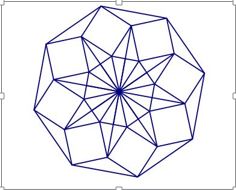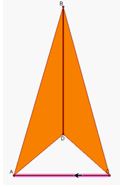
In his famous book ‘The Descent of Man’ and as part of a discussion on the sense of beauty Charles Darwin commented:
“The eye prefers symmetry or figures with some regular occurrence”.
(Darwin, 1887, p. 93).
In mathematics the definition for symmetry is precise, eg a 2 dimensional object is symmetrical if it is invariant under a reflection about a line, named the axis or line of symmetry. Although the material world hosts a great number of examples of symmetry, the exact mathematical definition of symmetry is not adequate to describe most of them because the symmetry is not usually exact (Zabrodsky et al, 1992). Humans are sensitive to approximate symmetry an example of which is the human face or body (Palmer, 1985). It appears that humans perceive objects as having degrees of approximation to symmetry. However in mathematics an object either has true symmetry or not (Shepard, 1994).
Humans appear to show a preference for vertical symmetry and this probably arises from the experience of living in an environment where objects possessing vertical symmetry are more common or by an appreciation that it is more efficient to process information by considering vertical symmetry. The force of gravity is likely to play a part in this and certainly the higher species of animals, including humans, show close to a vertical symmetry in their bodily forms. Some-one once told me that near symmetry in an animal demonstrates a healthy organism.
Vertical symmetry also stems from the natural framework of reference that we hold for the world about us. Perceptions of the material world are affected by gravity and privilege upright shapes with their base on a level with the horizontal (Piaget and Inhelder, 1956). The paradox is that, due to the curvature of the planet earth’s surface, verticals are not all parallel and surfaces of liquids are actually curved. However humans behave as if we live within a vertical and horizontal framework.
Symmetry, and especially reflective symmetry with a vertical or horizontal axis thus appear to be important to us and we actively seek symmetrical patterns. Work that I did for my doctoral thesis (Forsythe, 2014) indicated that humans have a sense of symmetry and can use this to place objects either side of the line of symmetry by eye fairly accurately. Thirteen year old students in my study worked with a Dynamic Perpendicular Quadrilateral (DPQ) which had fixed length perpendicular diagonals which could be dragged inside the figure to generate certain shapes, two of which can be seen below.


The students tended to drag the diagonals inside the DPQ to generate quadrilaterals where one diagonal acted as the axis of symmetry (usually the vertical axis). They were able to drag the diagonals, by ‘eye’, keeping very close symmetry of the shape, to make isosceles triangles, kites, concave kites, and a rhombus.
I gave some students a version of the DPQ which was oriented at an angle to the vertical. The students were still able to drag maintaining near symmetry but asked if there wasn’t some way we could turn the figure ‘the right way up’!
I believe that a sense of symmetry is important to the way in which we view the world and that we should make greater use of symmetry as a powerful tool in geometrical thinking. For example the symmetry of a kite leads to the understanding of the kite as made of two congruent triangles, which infers the two pairs of adjacent equal sides and the two equal angles. We could define a kite as a quadrilateral with one diagonal as a line of symmetry. However, if we wish to be more inclusive and accept the rhombus as a special case of the kite then we must define the kite as a quadrilateral with at least one diagonal as a line of symmetry.
Looking at shape properties through the lens of symmetry helps us to think of shapes from ‘the inside out’ giving us fresh insight and a new perspective on shapes (Forsythe and Cook, 2012). This can free us to consider more flexible definitions of shapes which work better with the concept of inclusion of one set of shapes in another, like the example of the rhombus and kite above.
References
Darwin, C. (1887). The Descent of Man (2nd edition), John Murray, London
Forsythe, S. and Cook, D., 2012. Learning about Properties of 2-D Shapes from the Inside out. Mathematics Teaching, 226, pp.5-8.
Forsythe, S.K., 2014. The kite family and other animals: Does a dragging utilisation scheme generate only shapes or can it also generate mathematical meanings? Accessible at https://lra.le.ac.uk/bitstream/2381/28915/1/2014ForsytheSKPHD.pdf
Palmer, S.E. (1985) The role of symmetry in shape perception. Acta Psychologica vol 59 pp 67-90
Piaget, J. and B. Inhelder (1956). The child’s conception of space. Routledge and Kegan Paul, London
Shepard, R. N. (1994). Perceptual-cognitive universals as reflections of the world. Psychonomic Bulletin & Review, 1(1), 2-28.
Zabrodsky, H., Peleg, S. And D. Avnir (1992) A measure of symmetry based on shape similarity. Computer Vision and Pattern Recognition, 1992. Proceedings CVPR ’92., IEEE
